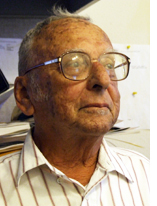
Conversations with My Ancestors by Andrew Sanders; Gefen Publishing House; 308 pages; no price listed.
By Norman Manson
SAN DIEGO–Genealogical research has become all the rage in recent years, aided by such institutions as the Mormon church, which possesses vast files of ancestral information. Family trees, going back several generations, have sprouted in abundance, including many involving Jewish families.
Andrew Sanders, a native of Hungary who now lives in Canada and Israel, has gone a step further in writing a fictionalized story of the lives of his Hungarian ancestors, going back almost two centuries. He has written mainly about imaginary conversations between himself and, especially, his long-deceased grandfather, Bernat Szekely.
The idea of conveying a family history in this fashion is intriguing, but the resulting book is flawed in some respects. Most important, it sometimes is difficult to discern who is speaking; Is it Andrew, Bernat, or one of his other dead ancestors who enters the picture?
Also, names were very often changed as the characters moved from one ethnic group to another. For example, Bernat’s surname was Steiner until 1898. And it seems everyone in the family was being called by a nickname or diminutive form of his or her full name. All told, this caused consdierable confusion for the reader. Finally, some rather inconsequential facts were included – one had to patiently plow through the text to find matters of real significance.
But some interesting historical facts are embedded in the family’s story. For one thing, there is the matter of the relationship of Hungary’s Jews with the country’s majority gentile population. According to Sanders, in the years before World War I, the Jews were constantly striving to become “real” Hungarians, to integrate themselves into the country’s economy, politics and society. Bernat’s name change is one example – he held a fairly high position in his community’s court system. It appears that the Jews, most of whom had migrated from elsewhere in the old Hapsburg Empire in the 17th, 18th and even 19th
centuries, felt they were being accepted to a great degree and desired more and more to be truly Hungarian. And it also appears that many of them had become relatively non-observant Jews – they were Neolog, equivalent to Reform in the West. And they generally did not attend synagogue services regularly, other than on the High Holy Days and other special occasions.
While this movement toward entering the mainstream in that era is well known in Germany and elsewhere in Western Europe, it has not been that well publicized in Hungary, which tends to be grouped with Poland and other East European nations in that respect.
But, starting with World War I, which saw Hungary defeated and dismembered and Jews blamed for the debacle -many of them came under Czech, Polish or Romanian rule – life went downhill for the Jewish community. And World War II of course was infinitely worse. Hungary joined Hitler, some family members were drafted and sent to the Russian front and many others perished in the Holocaust. Only a few final pages of the book deal with the horrors of World War II
While the book does have its flaws, Sanders’s valiant efforts to unearth the story of his ancestors, to flesh out details of their marriages, births, deaths. occupations and overall life stories – using a variety of sources – deserve high praise. In that respect, this truly is a monumental work.
*
Manson is a freelance writer based in San Diego. He may be contacted at norman.manson@sdjewishworld.com